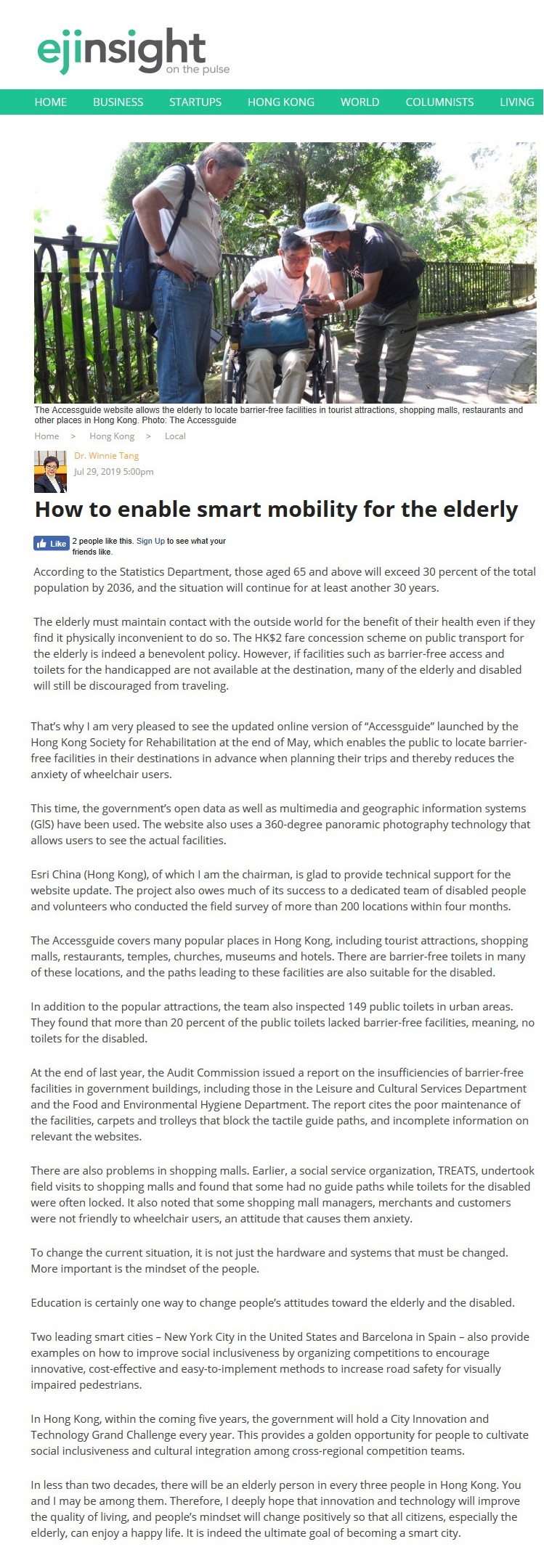網上版請按此

How to enable smart mobility for the elderly
According to the Statistics Department, those aged 65 and above will exceed 30 percent of the total population by 2036, and the situation will continue for at least another 30 years.
The elderly must maintain contact with the outside world for the benefit of their health even if they find it physically inconvenient to do so. The HK$2 fare concession scheme on public transport for the elderly is indeed a benevolent policy. However, if facilities such as barrier-free access and toilets for the handicapped are not available at the destination, many of the elderly and disabled will still be discouraged from traveling.
That's why I am very pleased to see the updated online version of "Accessguide" launched by the Hong Kong Society for Rehabilitation at the end of May, which enables the public to locate barrier-free facilities in their destinations in advance when planning their trips and thereby reduces the anxiety of wheelchair users.
This time, the government's open data as well as multimedia and geographic information systems (GlS) have been used. The website also uses a 360-degree panoramic photography technology that allows users to see the actual facilities.
Esri China (Hong Kong), of which I am the chairman, is glad to provide technical support for the website update. The project also owes much of its success to a dedicated team of disabled people and volunteers who conducted the field survey of more than 200 locations within four months.
The Accessguide covers many popular places in Hong Kong, including tourist attractions, shopping malls, restaurants, temples, churches, museums and hotels. There are barrier-free toilets in many of these locations, and the paths leading to these facilities are also suitable for the disabled.
In addition to the popular attractions, the team also inspected 149 public toilets in urban areas. They found that more than 20 percent of the public toilets lacked barrier-free facilities, meaning, no toilets for the disabled.
At the end of last year, the Audit Commission issued a report on the insufficiencies of barrier-free facilities in government buildings, including those in the Leisure and Cultural Services Department and the Food and Environmental Hygiene Department. The report cites the poor maintenance of the facilities, carpets and trolleys that block the tactile guide paths, and incomplete information on relevant the websites.
There are also problems in shopping malls. Earlier, a social service organization, TREATS, undertook field visits to shopping malls and found that some had no guide paths while toilets for the disabled were often locked. It also noted that some shopping mall managers, merchants and customers were not friendly to wheelchair users, an attitude that causes them anxiety.
To change the current situation, it is not just the hardware and systems that must be changed. More important is the mindset of the people.
Education is certainly one way to change people's attitudes toward the elderly and the disabled.
Two leading smart cities – New York City in the United States and Barcelona in Spain – also provide examples on how to improve social inclusiveness by organizing competitions to encourage innovative, cost-effective and easy-to-implement methods to increase road safety for visually impaired pedestrians.
In Hong Kong, within the coming five years, the government will hold a City Innovation and Technology Grand Challenge every year. This provides a golden opportunity for people to cultivate social inclusiveness and cultural integration among cross-regional competition teams.
In less than two decades, there will be an elderly person in every three people in Hong Kong. You and I may be among them. Therefore, I deeply hope that innovation and technology will improve the quality of living, and people's mindset will change positively so that all citizens, especially the elderly, can enjoy a happy life. It is indeed the ultimate goal of becoming a smart city.
Dr. Winnie Tang
Adjunct Professor, Department of Computer Science, Faculty of Engineering and Faculty of Architecture, The University of Hong Kong